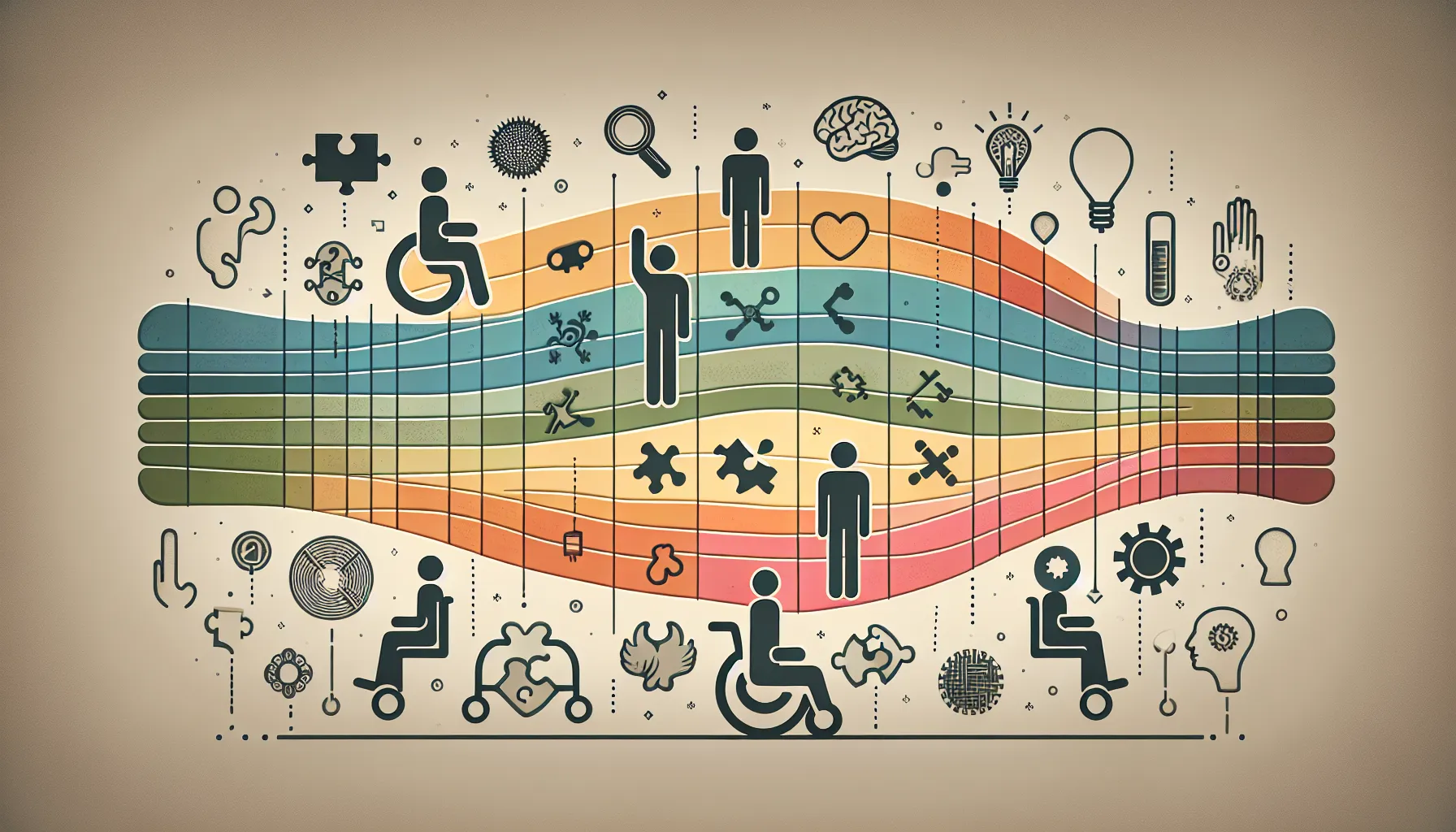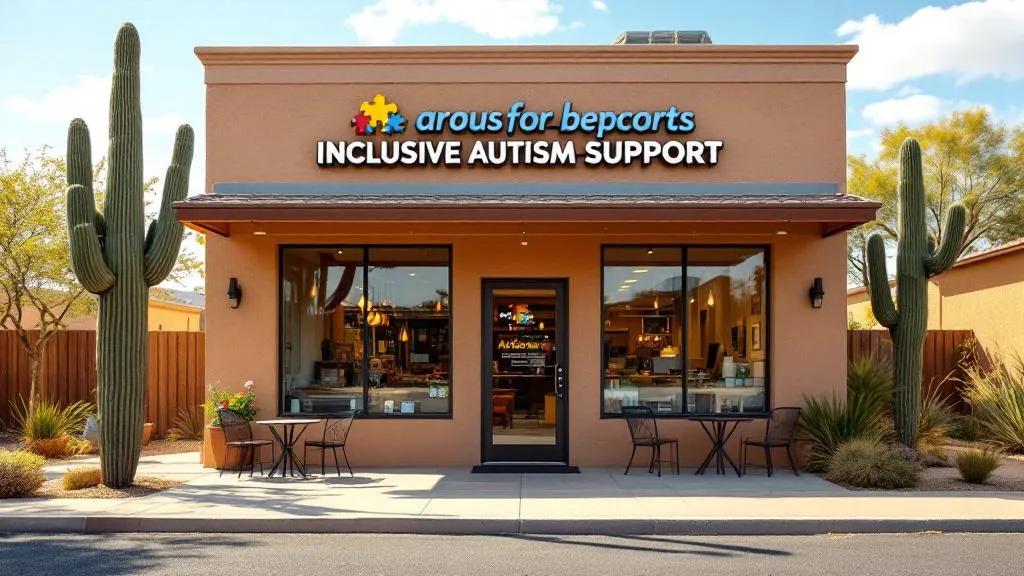Navigating the Spectrum: A Closer Look at Spectrum Disability
Discover the ins and outs of spectrum disability. From diagnosis to treatment, gain insight into this complex condition.

Understanding Spectrum Disabilities
Spectrum disabilities, specifically autism spectrum disorders (ASD), encompass a range of developmental conditions that affect individuals in various ways. These disorders are characterized by challenges in social interaction, communication, and behavior. Let's take a closer look at the definition of spectrum disorders and the severity levels associated with them.
Definition of Spectrum Disorder
ASD is a developmental disability caused by differences in the brain. The exact causes of ASD are not fully understood, but it is believed that a combination of genetic and environmental factors play a role in its development. Some individuals with ASD may have known genetic conditions, while the causes in others remain unknown.
Individuals with ASD may exhibit differences in how they behave, communicate, interact, and learn compared to most other people. The abilities of people with ASD can vary greatly, ranging from advanced conversation skills to being nonverbal. Some may require significant support in their daily lives, while others can function with minimal assistance.

Severity Levels of Spectrum Disorders
The severity of ASD is categorized into three levels based on the level of support an individual requires to navigate their daily life. These levels are determined by the presence of social communication impairments and restricted, repetitive patterns of behavior.
- Level 1 - Requiring Support: Individuals with Level 1 ASD require some support to meet their social communication demands. They may experience difficulties initiating and sustaining social interactions and may exhibit inflexible behaviors. However, their impairments do not significantly interfere with their daily functioning.
- Level 2 - Requiring Substantial Support: Individuals with Level 2 ASD require more substantial support to navigate social situations and manage their restricted, repetitive behaviors. They may have marked impairments in verbal and nonverbal social communication skills. Significant difficulties in adapting to change and restricted interests may also be present.
- Level 3 - Requiring Very Substantial Support: Individuals with Level 3 ASD require very substantial support across all areas of daily life. They have severe deficits in both verbal and nonverbal social communication skills and often demonstrate limited initiation of social interactions. Their inflexible behaviors significantly interfere with functioning, causing distress and requiring assistance.
It's important to note that the severity level of ASD is not fixed and can change over time. Early diagnosis and intervention are crucial in providing appropriate support and maximizing the individual's potential for development and independence.
Understanding the definition and severity levels of spectrum disabilities lays the groundwork for comprehending the challenges faced by individuals with ASD. In the following sections, we will explore the diagnostic criteria, characteristics, treatment approaches, and management strategies associated with spectrum disorders.
Diagnosis and Classification
Understanding the diagnosis and classification of spectrum disorders is essential in recognizing and addressing the unique needs of individuals. In this section, we will explore the diagnostic criteria for Autism Spectrum Disorder (ASD) and the differentiation of spectrum disorders.
Diagnostic Criteria for Autism Spectrum Disorder
To meet the diagnostic criteria for Autism Spectrum Disorder (ASD) according to the DSM-5, individuals must exhibit persistent deficits in three areas of social communication and interaction, as well as at least two of four types of restricted, repetitive behaviors. These deficits must be present in early childhood, even if they may not fully manifest until later.
The DSM-5 emphasizes the importance of evaluating each individual's strengths and challenges across multiple contexts. The diagnostic process involves comprehensive assessment and observation, considering the person's developmental history, behavior, communication skills, and social interactions.
It is important to note that the DSM-5 merged several conditions previously classified separately. This includes Asperger's syndrome, pervasive developmental disorder not otherwise specified (PDD-NOS), and autistic disorder, all of which are now encompassed within the Autism Spectrum Disorder diagnosis.
Differentiating Spectrum Disorders
While Autism Spectrum Disorder is the broadest classification, it is essential to differentiate between various spectrum disorders to provide appropriate support and interventions. The DSM-5 acknowledges the following distinctions:
- Asperger's syndrome: Falls on the milder end of the autism spectrum. Individuals with Asperger's may exhibit highly intelligent traits, specialized interests, and challenges with social interactions.
- Pervasive developmental disorder, not otherwise specified (PDD-NOS): Describes individuals who exhibit symptoms more severe than Asperger's but not as severe as autistic disorder. Symptoms can vary in intensity and manifest at an intermediate level.
- Childhood disintegrative disorder: The rarest and most severe part of the autism spectrum. Children with this disorder experience a sudden loss of social, language, and mental skills between ages 2 and 4, following a period of normal development. It is often accompanied by the development of a seizure disorder.
It is crucial for healthcare professionals and specialists to conduct thorough assessments and evaluations to accurately diagnose and differentiate spectrum disorders. This enables tailored interventions and support based on an individual's specific strengths and challenges.
Understanding the diagnostic criteria and differentiation of spectrum disorders is an important step towards supporting individuals with diverse needs. By recognizing and addressing the unique characteristics and challenges associated with these disorders, we can provide appropriate interventions and promote the well-being of individuals across the spectrum.
Characteristics of Spectrum Disorders
Individuals with a spectrum disorder exhibit a range of unique characteristics that impact their social communication and behavior. Understanding these characteristics is essential for recognizing and supporting individuals with spectrum disabilities.
Social Communication Impairments
One of the defining characteristics of spectrum disorders, such as Autism Spectrum Disorder (ASD), is social communication impairments. These impairments encompass a range of difficulties in social interaction and communication skills. Individuals with ASD may exhibit:
- Lack of appropriate eye contact and difficulty establishing or maintaining relationships.
- Challenges in understanding and using nonverbal communication, such as gestures, facial expressions, and body language.
- Difficulties initiating or responding to joint attention, which involves sharing focus or interest with others.
- Specific difficulties in receptive and expressive language, with some individuals being nonverbal and requiring alternative communication methods.
Restricted and Repetitive Behaviors
Individuals with spectrum disorders may also display restricted and repetitive behaviors, which are characterized by patterns of behavior, interests, or activities that are rigid and repetitive. These behaviors serve as a way to cope with sensory issues or provide comfort. Examples of restricted and repetitive behaviors include:
- Unusual and repetitive behaviors, such as rocking back and forth, pacing in circles, or rapidly flapping hands, which may manifest or increase in intensity during stressful situations.
- Sensory sensitivities, where individuals with ASD may be hypersensitive or hyposensitive to various sensory inputs. This can result in an aversion to certain textures, sounds, or lights, or an intense focus on specific sensory stimuli.
It's important to note that the specific characteristics and severity of social communication impairments and restricted and repetitive behaviors can vary from person to person within the spectrum. Understanding these characteristics helps create a supportive environment that respects individual differences and promotes inclusion.
Behavioral and Sensory Traits
Individuals with spectrum disabilities, such as Autism Spectrum Disorder (ASD), often exhibit unique behavioral and sensory traits. These traits can vary in intensity and presentation among individuals. Two common characteristics associated with spectrum disabilities are unusual and repetitive behaviors, as well as sensory sensitivities.
Unusual and Repetitive Behaviors
People with spectrum disabilities may engage in unusual and repetitive behaviors as a way to cope with sensory input, communicate their needs, or provide self-comfort. These behaviors can manifest in various ways, such as:
- Loud vocalizations: Some individuals may produce repetitive vocal sounds or phrases, which can serve as a way to regulate their sensory experiences or communicate specific needs.
- Physical movements: Rocking back and forth, pacing in circles, or rapidly flapping hands are examples of repetitive physical movements that individuals with spectrum disabilities may display. These behaviors can increase in intensity during stressful emotional conditions.
- Object fixation: Some individuals may develop a strong attachment to specific objects and display repetitive behaviors related to them, such as spinning wheels, lining up toys, or organizing items in a particular order.
- Rigid adherence to routines: People with spectrum disabilities often find comfort in following predictable routines and can become distressed when their routines are disrupted. They may exhibit strong resistance to changes and display repetitive behaviors to restore a sense of predictability.
These behaviors may serve as self-soothing mechanisms or ways to block out overwhelming sensory input. It is important to note that these behaviors are not inherently harmful and should be understood within the context of spectrum disabilities.
Sensory Sensitivities
Individuals with spectrum disabilities may also experience sensory sensitivities, which can make them more sensitive to certain stimuli in their environment [5]. Some common sensory sensitivities include:
- Auditory sensitivity: Certain sounds, such as loud noises or high-pitched tones, may be overwhelming or distressing to individuals with spectrum disabilities. They may cover their ears, exhibit avoidance behaviors, or become agitated in noisy environments.
- Visual sensitivity: Bright lights, flickering lights, or intense visual stimuli can be challenging for individuals with spectrum disabilities. They may demonstrate aversion to certain lighting conditions and prefer dimmer environments.
- Tactile sensitivity: Individuals with spectrum disabilities may have heightened sensitivity to touch and textures. Certain fabrics, tags on clothing, or even gentle touches can cause discomfort or distress. They may exhibit avoidance behaviors or seek specific tactile sensations for self-regulation.
- Olfactory and gustatory sensitivity: Some individuals may be hypersensitive to smells and tastes, finding certain odors or flavors overwhelming or unpleasant. They may exhibit strong preferences or aversions to certain foods, textures, or smells.
It is important to recognize and respect these sensory sensitivities as they can significantly impact an individual's daily life. Creating a supportive and sensory-friendly environment can help individuals with spectrum disabilities navigate their surroundings more comfortably.
Understanding and acknowledging the behavioral and sensory traits associated with spectrum disabilities is essential for promoting inclusion and providing appropriate support. By recognizing the unique characteristics of individuals with spectrum disabilities, we can foster a more inclusive and understanding society.
Treatment Approaches
When it comes to addressing spectrum disabilities, various treatment approaches are available to support individuals in managing their symptoms and improving their overall quality of life. Two commonly utilized treatment approaches for spectrum disabilities are behavior therapy, including Applied Behavior Analysis (ABA), and developmental and educational therapies.
Behavior Therapy and Applied Behavior Analysis (ABA)
Behavior therapy, including Applied Behavior Analysis (ABA), is a widely recognized and evidence-based treatment approach for individuals with Autism Spectrum Disorder (ASD). ABA focuses on encouraging desired behaviors and discouraging undesired behaviors through systematic behavioral interventions. The goal is to improve a range of skills, including communication, social interaction, and adaptive behaviors.
ABA employs techniques that involve breaking down skills into smaller, manageable steps and providing positive reinforcement to reinforce desired behaviors. Progress is measured and tracked to evaluate the effectiveness of interventions. This approach can be tailored to the unique needs of each individual, allowing for personalized treatment plans.
Developmental and Educational Therapies
Developmental and educational therapies play a crucial role in addressing spectrum disabilities. These therapies aim to enhance various aspects of an individual's development, including speech and language skills, daily living skills, and social interactions.
Speech and Language Therapy is commonly utilized to improve understanding and use of speech and language in individuals with spectrum disabilities. This therapy focuses on enhancing communication skills, such as expressive language, receptive language, and pragmatic language.
Occupational Therapy is another essential component of developmental and educational therapies. It helps individuals develop the skills necessary for independent living, including activities of daily living (ADLs), fine motor skills, sensory integration, and social interaction.
Educational treatments for spectrum disabilities often involve approaches such as the Treatment and Education of Autistic and Related Communication-Handicapped Children (TEACCH) method. This method emphasizes providing consistent structures and visual learning supports within a classroom setting to improve academic and other outcomes for individuals with autism.
Interventions that address social skills and emotional bonds are also important in managing spectrum disabilities. These social-relational treatments often involve the inclusion of parents or peer mentors to enhance social interactions and promote social-emotional growth.
It is worth noting that a combined treatment approach, incorporating multiple types of therapy, is often necessary to provide comprehensive support for individuals with spectrum disabilities. The specific treatment plan should be tailored to the individual's unique needs and strengths, and it may involve a combination of behavior therapy, developmental and educational therapies, social-relational treatments, and other supportive interventions.
By utilizing these treatment approaches, individuals with spectrum disabilities can receive the necessary support to enhance their communication skills, reduce challenging behaviors, develop independence, and improve overall functioning. The goal is to empower individuals with spectrum disabilities to reach their full potential and lead fulfilling lives.
Managing Spectrum Disorders
When it comes to managing spectrum disorders, a combination of approaches is often necessary to address the diverse range of symptoms and challenges individuals may face. Two key aspects of managing spectrum disorders include medication for co-occurring symptoms and supportive interventions and care.
Medication for Co-occurring Symptoms
While there are no medications that treat the core symptoms of Autism Spectrum Disorder (ASD), certain medications can be prescribed to help manage co-occurring symptoms that individuals with ASD may experience. These medications can assist in addressing symptoms such as high energy levels, inability to focus, or self-harming behaviors. Additionally, medication can be beneficial in managing co-occurring psychological conditions like anxiety or depression, as well as medical issues such as seizures, sleep problems, or gastrointestinal problems [6].
It is important to note that medication should always be prescribed and monitored by a qualified healthcare professional who specializes in the treatment of individuals with spectrum disorders. They will consider the individual's specific symptoms, medical history, and other factors to determine the most appropriate medication and dosage.
Supportive Interventions and Care
Supportive interventions and care play a vital role in managing spectrum disorders. These approaches focus on providing individuals with the necessary support, resources, and strategies to enhance their functioning and overall well-being.
Behavioral and Developmental Therapies
Behavioral therapies, such as Applied Behavior Analysis (ABA), have been shown to be effective in treating symptoms of ASD. ABA focuses on encouraging desired behaviors and discouraging undesired behaviors to improve a variety of skills. Progress is tracked and measured, allowing for individualized treatment plans.
Developmental and educational therapies are also essential components of supportive care for individuals with spectrum disorders. Speech and Language Therapy can improve understanding and use of speech and language, while Occupational Therapy focuses on teaching skills for living as independently as possible, such as dressing, eating, bathing, and relating to people.
Social-Relational Treatments
Social-relational treatments aim to improve social skills and emotional bonds in individuals with ASD. These treatments often involve approaches that incorporate parents or peer mentors to enhance social interactions. By providing guidance and opportunities for social engagement, individuals with spectrum disorders can develop meaningful relationships and improve their overall social functioning.
Educational Treatments
Educational treatments for ASD in a classroom setting can include approaches like the Treatment and Education of Autistic and Related Communication-Handicapped Children (TEACCH) method. This method focuses on providing consistency and visual learning structures to improve academic and other outcomes for individuals with autism. By tailoring educational strategies to the specific needs of individuals with spectrum disorders, these interventions can help optimize their learning experience and future success.
It is important to remember that managing spectrum disorders requires a comprehensive and individualized approach. The combination of medication, supportive interventions, and care can significantly improve the quality of life for individuals with spectrum disorders and support their overall development and well-being.
References
- https://www.webmd.com/brain/autism/autism-spectrum-disorders
- https://iidcweb.indiana.edu/irca/articles/characteristics-of-individuals-with-an-asd.html
- https://www.hhs.texas.gov/services/disability/autism/autism-training-opportunities/autism-spectrum-disorders-training-program-first-responders/module-4-common-behavior-characteristics-individuals-autism-spectrum-disorder-asd
Does Your Child Have An Autism Diagnosis?
Learn More About How ABA Therapy Can Help
Find More Articles
Contact us
North Carolina, Nevada, Utah, Virginia
New Hampshire, Maine
Arizona, Colorado, Georgia, New Mexico, Oklahoma, Texas
.avif)


































































































